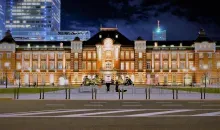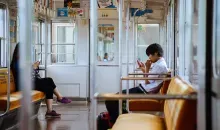How to get from Kyoto to Kanazawa
See the best way to get from Kyoto to Kanazawa using the Thunderbird Limited Express Train and Shinkansen bullet train!
How to get to from Kyoto to Kanazawa with the Thunderbird Limited Express and Hokuriku Shinkansen
2 hours 50mins
Kanazawa Station
Though there is no direct means of train travel between Kyoto and Kanazawa, the journey is still simple with one transfer utilizing the Thunderbird Limited Express Train and Hokuriku Shinkansen. The trip between the two is certainly worth doing as well. Though Kyoto and Kanazawa are often compared, each city has its own worthwhile destinations and attractions to see and visit.
Kyoto, being the ancient capital of Japan, is a city rich with history and culture, showcasing some of the most iconic locations, not just in Japan, but in the world as a whole. Climb up the hill overlooking the city and see the multi-faceted complex of Kyomizudera. See one of the most Japanese-esque scenes at Arashiyama and the gold and silver temples of Kinkaku and Ginkaku. Then, of course, take advantage of the more mellow and subtle neighborhoods in a city as stylish as this and see how the locals spend their time.
Kanazawa is often cited as a “mini-Kyoto,” also teeming with history due to being nearly untouched during World War II. But don’t let this moniker fool you, as Kanazawa is a destination worth visiting on its own. The city’s name translates to “gold marsh,” and the elegant environment that is apparent everywhere reflects the opulent name. Indeed, Kanazawa is a city best described as a place with a true appreciation for all things beautiful. From the Katamachi shopping district to the 21st Century Contemporary Art Museum, a high-class sense of relaxation awaits throughout the city.
Trains available on this itinerary:
| Thunderbird Limited Express Train | Kagayaki Shinaknsen Bullet Train |
Reserving seats on the Shinkansen
On Shinkansen bullet trains, individual ticket holders and holders of Japan Rail Passes can reserve seats in advance of boarding. Reservations are not always required for Shinkansen bullet trains because many of them have non-reserved cars with seats that are available on a first-come, first-served basis. These are often car numbers 1-4.
There are some trains when all cars require a reservation, even though a lot of people utilize the Shinkansen bullet train services during these hours. However, we also strongly advise all visitors to try and book reservations for tickets during Japan's busiest travel seasons, which include the spring and the New Year's holiday. When purchasing a single ticket, a reserved seat costs more; however, Japan Rail Pass users will not be charged an additional cost.
Oversized Baggage on the Shinkansen
NOTE: The following baggage regulations only apply to the Tokaido-Sanyo Shinkansen. Other Shinkansen lines and Limited Express Trains do not have specific regulations in regards to oversized baggage.
In order to board the bullet train, passengers who are carrying a lot of luggage must follow certain rules. According to Japan Railway regulations, any baggage exceeding 160 cm in length, width, and height needs to be checked into the special bulky baggage section at the back of the train car. Owners of such bags must additionally make reservations for seats near this section. Please be advised that baggage exceeding 250 cm in total is not permitted on the Shinkansen bullet train.
Baby carriages, musical instruments in cases, and sporting goods (bikes, snowboards, etc.) in cases are all excluded from these baggage limits.
Exploring Kyoto
Kyoto, the historic capital of Japan, is a culturally vibrant city brimming with history and home to 17 distinct UNESCO Heritage Sites. Kyoto is situated in the Kansai region, a culturally varied area of Japan renowned for its colorful locations. For visitors taking the Japan Golden Route, Kyoto is frequently the next stop after Tokyo.
The temple itself and the ascent to Kyomizudera are two of Kyoto's most famous sights, and both are worthwhile excursions. Explore a little off the usual route; the hilly lanes leading up to the temple are lined with quaint stores and eateries! Then, Ginkakuji and Kinkakuji, the "gold and silver temples," serve as potent representations of Kyoto's lengthy past.
Kyoto is a metropolis, but it's not like other big towns in Japan because it has mountains on three sides and a lot of traditional architecture instead of tall skyscrapers. Benefit from Kyoto's distinctive topography by spending some time on a leisurely trek where you can take in the surrounding scenery. One of the simpler walks in the area is from Shogunzuka to Seiryuden, which takes around two hours to reach Chion-in Temple. Enjoy an unrestricted perspective of the city from a high vantage point and discover Kyoto in a way you never would have imagined.
Travelers arrive at Kyoto Station and are immediately in the heart of the historic capital. Not many towns in the world can match Kyoto's distinction of being the first city to commemorate its 1200th anniversary—a feat that was accomplished in 1997 when the station underwent its current design by renowned architect Hiroshi Hara.
There are a few convenience stores, cafes, and restaurants inside the station, however, it is not as big as other important stations like Tokyo Station, Shinjuku Station, or even Hakata Station. Nonetheless, the lit staircase—whose display varies with the season—is one of Kyoto Station's most identifiable features. Conveniently located near the station, the well-liked Ume-yu is a sento bathouse with a charming atmosphere that's perfect for lounging and passing the time in a relaxed, residential area, complete with unique and eccentric merchandise to bring home.
Exploring Kanazawa
Kanazawa is often described as a city that emphasizes beauty above everything else. Ishikawa Prefecture's capital, which is one of the most populous city in Hokuriku, was largely spared from the destruction caused by World War II, preserving its historic neighborhoods and customs related to crafts to this day. The modern Hokuriku Shinkansen station is fully walkable, making it a perfect location for exploration and discovery.
The word "golden marsh" comes from the name Kanazawa, which is well reflected in a number of the city's attractions. Gold details are used in many crafts made in this city, which is well known for its artistic talent. These crafts may be seen in a wide variety of galleries and workshops spread out over the city.
Kanazawa is also home to one of Japan's three most well-known gardens, Kenroku-en. The garden opened to the public in the late 1800s, and it offers seasonal nightly illuminations throughout the spring cherry blossom season and the fall leaf change. This central location is a hub for entertainment and events, as it is adjacent to both the 21st Century Contemporary Art Museum and the ancient Kanazawa Castle. A trip to Higashi-chaya is essential for a more thorough examination of Kanazawa's rich history. Several of the original buildings from centuries ago may still be found in this charming tea sector, making it an ideal location for pictures. Many visitors from within and outside of Japan wander about this area of Kanazawa while donning traditional yukata.
Traveling from Tokyo across Honshu Island to the Japan Sea Coast, the Hokuriku Shinkansen passes past Kanazawa Station before continuing on to Tsuruga in Fukui as of March 2024. From Tokyo Station, the Shinkansen bullet train travels to Ueno Station. The main feature at Kanazawa Station is the enormous gate-like structure known as Tsuzumimon Gate. This structure is meant to resemble both a traditional Japanese drum known as a tsuzumi and a torii gate from Shintoism. From a distance, many people believe that the gate's placement and the station's dome resemble a samurai helmet, and the gate has come to symbolize Kanazawa itself.
Two of Japan’s most premier cities and premier trains!
Using a combination of both the iconic Thunderbird Limited Express Train and the Shinkansen bullet train, the journey between two of Japan’s most culture-rich cities, Kyoto and Kanazawa, is made easy! Witness history and modern-day beauty with this itinerary, taking not even two hours of transit using some of the world’s most cutting edge means of transportation.












